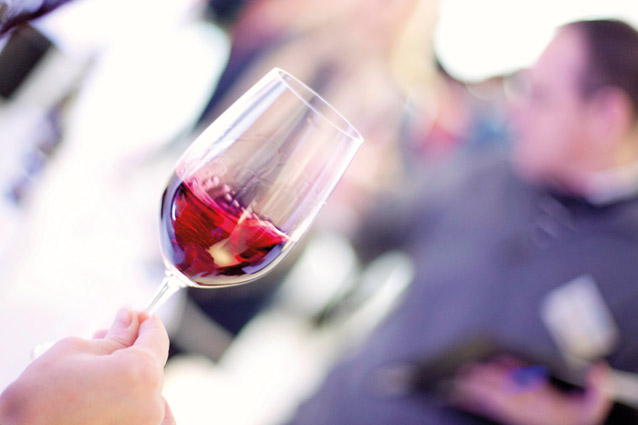Having covered Chile separately, the performance of the other New World countries rounded off an impressive year for non-European Bordeaux-varietal reds. Whereas we might usually get two or three non-Chilean places on the Gold List, this year we had an unprecedented eight.
Australia, South Africa, Argentina et al didn’t so much break through the glass ceiling as smash it into a million bits, melt it down and re-mould it into a giant sculpture saying ‘Up Yours Bordeaux’ for their mantelpiece.
 ‘We got a bit excited with this flight,’ said Hotel TerraVina’s Laura Rhys MS in the early rounds as she surveyed a highly rewarded flight of Aussies. But it was easy to see why. Consistency? Check. Drinking well now? Check. Value for money? Check. Just.
‘We got a bit excited with this flight,’ said Hotel TerraVina’s Laura Rhys MS in the early rounds as she surveyed a highly rewarded flight of Aussies. But it was easy to see why. Consistency? Check. Drinking well now? Check. Value for money? Check. Just.
In fact, if one wanted to be picky (and this, after all, is the lot of the journalist), it has to be said that prices were high across the board. Chile’s Cabs might be a bit predictable, but at least they are cheap. Fewer than 25% of the Cab-Merlot medal winners from the rest of the New World were under £10.
That said, our tasters seemed happy enough with what they were seeing to be able to justify the expense, with the Australian wines, in particular, delivering not just better balance than in the past, but even some genuine typicity.
‘There were real differences between the Coonawarra and the Margaret River flights,’ said The French Table’s Sarah Guignard. ‘It’s good to see that. I was expecting Australia overall to be much bigger and richer. I was pleasantly surprised.’
The issue, in fact, was not whether the wines were worth the prices so much as whether the public would be prepared to pay them. The off-trade, it seems, has done a good deal of damage to the country’s reputation. ‘People are so used to seeing walls of cheap Australian wine in the supermarket that it’s diluted their reputation,’ lamented Alex Sergeant from The Harwood Arms. ‘At around £100 on a list, you need a name…’
If you were looking for value for money, then on this evidence Chile’s neighbour looks like the best bet. Argentina might (as usual) have had more confidence about charging big money than its long skinny counterpart to the west, but it also managed to deliver a good number of medal-winning wines around the £10 mark.
For a country that has regularly struggled to pick up more than a few Silvers, its performance this year was something of a revelation. Of course, there was a good deal of expensive oak, ripe fruit and, frankly, showing off by the wineries, but those that showed a touch less ego and were less obviously attempting to woo Kansas_oaklover55 managed to combine finesse, ripeness and generosity in an impressive package.
‘I was expecting to find ripe fruit, fairly concentrated wines, but ones that still revealed the structure and profile of good Cabernet, and the best did precisely this, and at fair prices,’ said Matthew Cocks of Cubitt House. ‘The medal winners reflected wines that are drinking now – that combined some freshness and elegance with concentration, and would work with food.’
South Africa, too, rather came of age this year. Of course, the tasters had to accept that (under £10 at least) the wines would have that typical ‘chocolate plus smoke’ character – some of them even quite liked its ‘South African-ness’!
But though there was only one Gold (the impressive Kleine Zalze, which also picked up a Critics' Choice) the high number of Silvers suggests that things are moving in the right direction. ‘They know a little bit more now,’ mused Bo London’s Cedric Beaumond. ‘They are more commercial, more gentle and they really make the wine for the market – a little bit mellow.’
The only reservation was that, as The Marylebone Hotel’s Mark Deamer pointed out, ‘the more you pay for them the less you can justify having them on your list’. South Africa has very few ‘big name’ producers to part the sceptical UK diner from his hard-earned.
The same cannot be said of California, which is just as well, since the pricing here was eye-watering. The Chimney Rock was a terrific wine, but also significantly more expensive than any of our Bordeaux equivalents.
But at least the US managed some medals. New Zealand was, once again, atrocious here, with nothing coming close to medalling, let alone finding a place on the Gold List. Its thin, green, under-ripe, over-priced procession of
misery was, however, atypical of what was a highly successful category.
‘There’s a real sense this year that New World Bordeaux varieties can deliver across the price points,’ said Hakkasan Group’s Christine Parkinson as she put the final Gold List together.
‘Australia at the top end has always been quite expensive. But people will pay £50 on a list for them.’
Sarah Guignard, The French Table
‘The oak use is lower than it used to be. You can taste the fruit character better now.’
Marco Adreani, The Pass at South Lodge